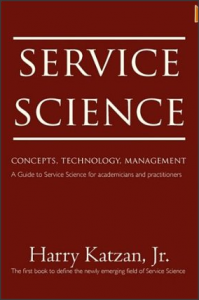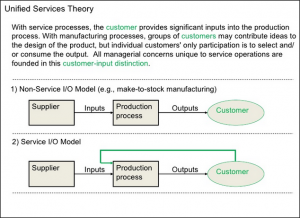I have been looking at service systems and service science and have bought the book Service Science by Henry Katzan, Jr. (Available from Amazon)

The book explains service science theory as the underpinning concept of service systems as described by IBM as SSME. I have decided that to undertake a piece of research on the development of a customer service team into a service systems team I am going to use Unified Service Theory as my main underlying theory. The theory is summed up in the following diagram:

Unified Service Theory
UST in full: With services, the customer provides significant inputs into the production process. With manufacturing, groups of customers may contribute ideas to the design of the product, however, individual customers’ only part in the actual process is to select and consume the output. Nearly all other managerial themes unique to services are founded in this distinction. (From Understanding Services Businesses)
Defining by Customer Content:
With services, an effective means of understanding, analyzing, and comparing processes is on the basis of customer content. There are three general types of customer inputs into service processes: the customer’s self, the customer’s belongings, and/or the customer’s information. This principle occurs because customer inputs are present in all services, in accordance with the Unified Services Theory.
Identifying the Customer:
With services, “the customer” is sometimes not clearly defined. Generally, the customer is the individual or entity who directly or indirectly decides whether or not the firm shall be compensated for production. The actual paying customer may desire a non-paying “critical audience” to be satisfied with production, qualifying the critical audience as an indirect customer. This principle occurs because companies can have many stakeholders, some providing inputs and some merely consuming outputs. Since the Unified Services Theory is based on the idea of customerinputs, it is necessary to clearly define who the customer is.
Identifying the Production Process:
With services, the company’s Uproduction process is defined as company effort to add value to customer inputs. Company effort in preparation for production is the pre-production process. When the production process concludes, and the customer may use the production outcome to continue to add value. This post-production process is primarily based on customer action. Often, well-designed service outcomes will enable the customer to create value in the post-production process. This principle occurs because the only ways companies can add value is through efforts and through outputs. Efforts can add value directly to customer inputs (given by the Unified Services Theory). Outputs, or outcomes, can allow customers to add value after the company’s production efforts are complete.
The Unit of Analysis:
With services, the unit of analysis is a process segment. A process segment is a sequence of steps of production. When processes are dissected into smaller segments, the presence or absence of service principles becomes more pronounced. This principle occurs because customer inputs are present in some parts of a production process, but not present in others. By the Unified Services Theory, the parts that involve customer inputs identifies the process segment as a service process.
Weighting the Mixture:
With services, different process segments have different degrees of customer input, and some may have none (acting as manufacturing). The weight, or significance, of specific process segments is most often determined by the amount of value in the overall service contributed by specific segments. This can be approximated by contribution to “willingness to pay.” Some other segments are important for accounting, regulatory, or risk-control reasons. This principle occurs because value of a service process or of individual process segments is judged by how well it adds value to customer inputs. The noted exception is process steps that protect the company’s ability to remain in business by meeting regulatory or risk-control requirements, or by keeping an accurate accounting of production, revenues, and costs.
As seen from the diagram the main idea behind UST is that the customer is a key part of the service system. This is the underlying concept for service value co-creation where the service provider and the service client both gain value from the service operation. For the research project (assignment and probably main project) I intend to use UST as the main theory for developing the service (within an Action Research project) Actor-Network Theory for investigating the background and the various human and non-human actors and Sensemaking theory for reflecting on what has happened.


